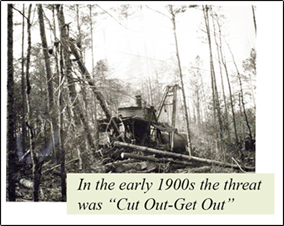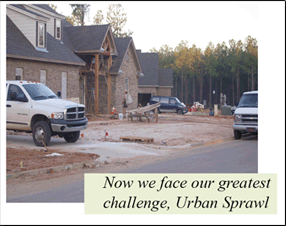Management of the wildland urban interface (WUI) continues to increase in importance. Whether it is fires like the California Woolsey and Camp Fires in 2018, invasive species such as the emerald ash borer, or severe weather blowing down trees in a subdivision, the land where people reside within the forest edge requires thoughtful, long-term management. The links and documents at the bottom of this page include description of the National Fire Protection Association’s Firewise USA program and other aids to make prudent city, community, subdivision, and individual homeowner decisions for safely and productively living in harmony with forest and other wildlands.

Although natural disasters such as wildfire and hurricanes have always had an impact on our forests, many threats to our timberland assets have been created through man’s exploitation. Such was the case in the early 1900s when the practice of “Cut Out-Get Out” clearly indicated that current thinking believed our timber resources were inexhaustible. Thousands of acres of timberland were cutover and wildfire was rampant. And there was no effort to replant trees on the acreage cut or burned.
Fortunately, conservation-minded citizens and government officials saw the fallacy with such thinking and began the first national efforts to protect timberland. A variety of federal and state agencies were created to help meet these challenges, such as the Alabama Forestry Commission and the Department of Conservation and Natural Resources. Forest landowners began receiving technical help from professional foresters and eventually, the forests were reestablished. Those efforts have since provided the citizens of Alabama an enormous opportunity in the form of job creation, clean water and air, and abundant recreational prospects.
However, Alabama’s forests are once again facing the real and genuine threat from unabated and unplanned growth. The continued demand for growth from the city for more urban development is consuming thousands of acres of forestland annually. A recent study calculated that between 1970 and 1990, urban sprawl consumed almost 40,000 acres of forestland in the Mobile Bay area alone.

As our cities and towns grow, the impacts on forest lands are becoming more serious. Ownership of forested tracts is being fragmented into smaller units. Forest vegetation and ecosystems are being broken apart into isolated pieces, often replaced by exotic or invasive species. Forested tracts that once provided valuable functions, such as water quality, air quality, wildlife, scenery, recreation, and timber products, are being lost or replaced by other land uses. Like the challenges that faced our state 100 years ago, this one will require state and local governments, private enterprise, and the general public to work together to meet it head-on. Key questions need to be addressed. What are the risks? What are the costs? And what are the answers?
Solutions to our forest challenges require public awareness and involvement. That’s especially true in the case of urbanization and its impact on Alabama’s forests. Proactive collaberation with an informed electorate is the only way we can address this issue and make sure that our state’s forests remain prosperous and productive for all citizens.
City Resources
Community Resources
Homeowner Resources
Subdivision Resources